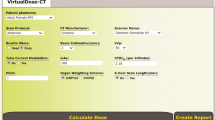Abstract:
The aim of the current study was to estimate the embryo/fetus radiation doses and risks associated with spinal and hip dual X-ray absorptiometry (DXA) scans performed on the pregnant mother. The results were compared with the embryo/fetus dose from a thoracolumbar radiograph and pelvic radiograph. Posteroanterior (PA) lumbar spine and proximal femur scans during the first, second and third trimesters were performed on a phantom simulating pregnancy at the three trimesters of gestation. All scans were carried out using a Hologic 1000/W pencil beam DXA unit. Moreover, embryo/fetus doses from a (a) thoracolumbar radiograph and (b) pelvic radiograph were estimated for all periods of gestation using the same phantom. Radiation doses were measured using thermoluminescent dosimeters. The dose reduction achievable by shielding the embryo/fetus with a protective apron during DXA scans was studied for all trimesters of gestation. The embryo/fetus doses during the first trimester were measured to be 1.7 mGy and 2.7 mGy for the PA spine and femur DXA scan, respectively, for an embryo/fetus located 8.5 cm from the anterior maternal surface. The risk of excess fatal cancer was 0.2 per million unborn children irradiated in utero for measurements of the spine and 0.3 per million unborn children for measurements of the femur. The embryo/fetus doses during the second and third trimesters were 2.7 mGy and 4.9 mGy respectively for the scans of the lumbar spine. The risk of childhood fatal cancer was 0.3 per million for the second trimester and 0.5 per million for the third trimester. The embryo/fetus radiation doses during the second and third trimesters were estimated as 1.4 mGy and 1.0 mGy respectively for the examinations of the proximal femur. The risk of childhood fatal cancer was 0.1 per million for both trimesters. The use of the apron resulted in a very small change in the dose absorbed by the embryo/fetus. The embryo/fetus dose associated with both DXA modes investigated in the current study is at least 700 times lower in comparison with embryo/fetus dose from a thoracolumbar or pelvic radiograph in all periods of gestation. In conclusion, the embryo/fetus dose in bone density measurements of spine and femur using pencil beam DXA is lower than the average daily natural background in the United States of 8 mGy. The health provider can decide whether a DXA scanning is beneficial to a pregnant woman, taking into account the potential radiation risks to the embryo/fetus presented in the current study.
Similar content being viewed by others
Author information
Authors and Affiliations
Additional information
Received: 14 December 2001 / Accepted: 22 May 2002
Rights and permissions
About this article
Cite this article
Damilakis, J., Perisinakis, K., Vrahoriti, H. et al. Embryo/Fetus Radiation Dose and Risk from Dual X-ray Absorptiometry Examinations . Osteoporos Int 13, 716–722 (2002). https://doi.org/10.1007/s001980200098
Published:
Issue Date:
DOI: https://doi.org/10.1007/s001980200098




